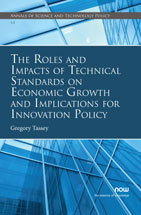The Roles and Impacts of Technical Standards on Economic Growth and Implications for Innovation Policy
By Gregory Tassey, Economic Policy Research Center, University of Washington, USA, gtassey@outlook.com
Abstract
Modern technologies are complex systems, which creates demand for an equally complex supporting technical infrastructure that is implemented through a variety of standards affecting all stages of technology-based economic activity. The development, production, and integration of the components of technology-based systems require standards for such disparate functions as materials characterization, equipment calibrations, setting data formats, and consummation of market transactions. These functions of standardization not only increase productivity but assure domestic customers and those in other economies that a component will perform as desired within the broader product system technology. The trend in corporate strategy toward specialization and the resulting networks of firms that develop, disseminate, and integrate these technologies mean a greater distribution of R&D among materials and component suppliers and integrators of product and service systems that now characterize high-tech supply chains. The consequent increase in market transactions requires an additional standards infrastructure to reduce the greatly increased costs involved in consummating these transactions between suppliers and users. The need to be commonly used means standards have publicgood characteristics, which leads to underinvestment in their technological content and in the processes for actually promulgating them and managing their use over a technology’s life cycle. Further, because standards are a heterogeneous infrastructure, having multiple forms and hence economic roles, different combinations of public and private investment in the supporting “infratechnologies” are needed. In response to the need to effectively manage the multiple roles of standards, this monograph assesses their economic nature and impacts over the entire technology life cycle and the consequent implications for public policies required to effectively provide this critical infrastructure.
The Roles and Impacts of Technical Standards on Economic Growth and Implications for Innovation Policy
The Roles and Impacts of Technical Standards on Economic Growth and Implications for Innovation Policy assesses the economic nature, roles, and impacts of technical standards over the entire technology life cycle and the required public policies to effectively provide this critical infrastructure.
The author uses a public-private asset model to characterize and assess the various functions of standards over a technology’s life cycle. An accurate asset-based growth model must incorporate the infrastructure character of standards, including their specific functions across the technology life cycle. Doing so is necessary to understand their economic impacts and the complementary roles of industry and government in developing and promulgating them. In addition, the dynamic nature of technology evolution is also a critical element of such a model, because the timely creation, modification, and application of standards can be just as important for economic growth as their structure. Thus, maximizing long-term economic growth requires continual adjustments to standards and their development strategies.
